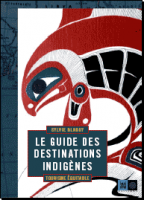Indigenous Destinations : A Window on the Cultural and Biological Diversity of Our Planet
EcoCurrents Quarterly Newsletter
A unique new guidebook by TIES Board member Sylvie Blangy describes 184 indigenous-led ecotourism projects in some 70 different countries. The book, published in French by Indigène Editions, will be released in February 2006. Given the enthusiasm and advance publicity generated by this book, an English edition is also being planned for late 2006.
TIES Executive Director Martha Honey wrote the Foreward, and TIES members played a major role in identifying and describing the case studies. The project has been supported by the French, Dutch and German development assistance agencies who have already purchased 600 copies. The logos of TIES and the three development agencies will appear on the back cover.
The contributions, written variously by community leaders, visitors or consultants, or facilitators, include a report from the location, the cultural setting, and a description of a sample tour package.
This volume, the first of its kind in French, demonstrates the diversity and richness of indigenous tourism around the world. It shows a wide range of experiences, ecosystems, cultures, languages, activities, and livelihoods that is unequalled by conventional tourism. Most of these tourism projects grew out of land claims based on forced relocations of indigenous groups or from conflicts with mining companies. Typically, the indigenous communities partern with private sector tourism operators or development agencies.
For instance, Seattle, Washington-based Wildland Adventures (a long time TIES member) and MERC (Maasai Environmental Resource Coalition) have formed a partnership in running tours in Kenya that provide benefits to local communties ( see EcoCurrents, first quarter, 2005). In another example. the Venezuela-based travel agency Natura Raid has invested for more than five years in providing training, advice, and loans to the Ye’kwana. community of the Upper Rio Caura and the Warao in the Orinoco Delta. Community members have full ownership of the lodge and canoe equipment, and in charge of handling small groups of visitors.
The NGO Tourisme et Développement Solidaire, which is supported by the French Cooperation Agency, is providing assistance and expertise to several villages in the West African countries of Burkina Faso and Benin. Today, five “host villages” in these countries are offering visitors full immersion packages based on sharing daily activities. A new network of “host villages” has emerged throughout French speaking Africa.
In addition to these lesser known examples, the book also covers well known case studies
such as the Community Baboon Sanctuary in Belize, Posadas Amazonas Lodge in Peru, Kapawi Lodge in Ecuador, Chalalan Lodge in Bolivia, as well as the Makuleke community in Kruger National Park, South Africa.
While indigenous tourism is today very popular, and growing numbers of local communities are turning to ecotourism, even the oldest and most successful case studies face challenges. One of the most common is how to successfully market lodges in remote locations. Increasingly, community-based tourism operators are forming federations or networks at a country or regional level to market to overseas clients. Some of the older networks such as Nacobta, the Nambia Community Based Tourism Association, are being consolidated and expanded to serve neighboring countries. More recent is the Himalayan Homestays network that promotes village accommodations run by Ladakhi or Sikimi women and is expanding all over the Himalayan range. Elsewhere, in Guatemala and Guyana for instance, indigenous tourism associations or federations have been initiated by communities themselves.
These community organizations are starting to attract international attention, especially in Europe. Some 40 small NGOs and communities were represented at the 2005 Reisepavillon ecotourism fair in Hanover, Germany. The French press, previously reluctant to report on ecotourism, has recently begun to focus on responsible tourism projects. Indigenous and community tourism is also paving the way in less developed countries in southern Europe where the introduction of concepts such as sustainability, equity, fairness and solidarity are helping to generate new partnerships with host communities.
The guidebook’s author, Sylvie Blangy, is a consultant in ecotourism, a university lecturer, and a doctorate student in community based tourism and management of natural resources. The guide will be distributed in bookstores and FNAC by Harmonia Mundi, in France as well as in Belgium, French-speaking Switzerland and Quebec. It is available at the TIES online store at 30 Euros An English version is planned for late 2006.



